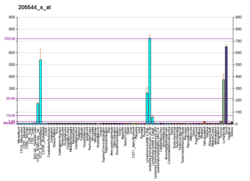Complement receptor 2
Complement receptor 2 (ингл. ) — аксымы, шул ук исемдәге ген тарафыннан кодлана торган югары молекуляр органик матдә.[15][16]
Искәрмәләр[үзгәртү | вики-текстны үзгәртү]
- ↑ 1,0 1,1 UniProt
- ↑ Holers V. M., Szakonyi G., Asokan R. Human complement receptor 2 (CR2/CD21) as a receptor for DNA: implications for its roles in the immune response and the pathogenesis of systemic lupus erythematosus (SLE) // Molecular Immunology — Elsevier BV, 2013. — 12 p. — ISSN 0161-5890; 1872-9142 — doi:10.1016/J.MOLIMM.2012.07.002 — PMID:22885687
- ↑ Holers V. M., Boackle S. A. Cr2, a candidate gene in the murine Sle1c lupus susceptibility locus, encodes a dysfunctional protein // Immunity — Cell Press, Elsevier BV, 2001. — ISSN 1074-7613; 1097-4180 — doi:10.1016/S1074-7613(01)00228-X — PMID:11728339
- ↑ 4,00 4,01 4,02 4,03 4,04 4,05 4,06 4,07 4,08 4,09 4,10 4,11 GOA
- ↑ L Clemenza, Isenman D. E. Structure-guided identification of C3d residues essential for its binding to complement receptor 2 (CD21) // J. Immunol. — Baltimore: 2000. — ISSN 0022-1767; 1550-6606 — doi:10.4049/JIMMUNOL.165.7.3839 — PMID:11034390
- ↑ 6,0 6,1 6,2 6,3 Moore M. D., Cooper N. R., Tack B. F. et al. Molecular cloning of the cDNA encoding the Epstein-Barr virus/C3d receptor (complement receptor type 2) of human B lymphocytes // Proc. Natl. Acad. Sci. U.S.A. / M. R. Berenbaum — [Washington, etc.], USA: National Academy of Sciences [etc.], 1987. — ISSN 0027-8424; 1091-6490 — doi:10.1073/PNAS.84.24.9194 — PMID:2827171
- ↑ 7,0 7,1 Harley J. B., Holers V. M. Genomic organization and polymorphisms of the human C3d/Epstein-Barr virus receptor // J. Biol. Chem. / L. M. Gierasch — Baltimore [etc.]: American Society for Biochemistry and Molecular Biology, 1989. — ISSN 0021-9258; 1083-351X; 1067-8816 — PMID:2563370
- ↑ M Barel, M Balbo, A Gauffre et al. Binding sites of the Epstein-Barr virus and C3d receptor (CR2, CD21) for its three intracellular ligands, the p53 anti-oncoprotein, the p68 calcium binding protein and the nuclear p120 ribonucleoprotein // Molecular Immunology — Elsevier BV, 1995. — ISSN 0161-5890; 1872-9142 — doi:10.1016/0161-5890(95)00005-Y — PMID:7753047
- ↑ Ghai R., Coulson E. J., Collins B. M. et al. Structural basis for endosomal trafficking of diverse transmembrane cargos by PX-FERM proteins // Proc. Natl. Acad. Sci. U.S.A. / M. R. Berenbaum — [Washington, etc.], USA: National Academy of Sciences [etc.], 2013. — ISSN 0027-8424; 1091-6490 — doi:10.1073/PNAS.1216229110 — PMID:23382219
- ↑ Buschow S. I., Stoorvogel W., Wauben M. MHC class II-associated proteins in B-cell exosomes and potential functional implications for exosome biogenesis // Immunology & Cell Biology — Wiley, 2010. — ISSN 0818-9641; 1440-1711 — doi:10.1038/ICB.2010.64 — PMID:20458337
- ↑ 11,0 11,1 GOA
- ↑ Harley J. B., Holers V. M. Genomic organization and polymorphisms of the human C3d/Epstein-Barr virus receptor // J. Biol. Chem. / L. M. Gierasch — Baltimore [etc.]: American Society for Biochemistry and Molecular Biology, 1989. — ISSN 0021-9258; 1083-351X; 1067-8816 — PMID:2563370
- ↑ Buschow S. I., Stoorvogel W., Wauben M. MHC class II-associated proteins in B-cell exosomes and potential functional implications for exosome biogenesis // Immunology & Cell Biology — Wiley, 2010. — ISSN 0818-9641; 1440-1711 — doi:10.1038/ICB.2010.64 — PMID:20458337
- ↑ 14,0 14,1 GR N., ME M., NR C. Binding of monoclonal antibody to the Epstein Barr virus (EBV)/CR2 receptor induces activation and differentiation of human B lymphocytes // J. Immunol. — Baltimore: 1985. — ISSN 0022-1767; 1550-6606 — PMID:2995485
- ↑ HUGO Gene Nomenclature Commitee, HGNC:29223 (ингл.). әлеге чыганактан 2015-10-25 архивланды. 18 сентябрь, 2017 тикшерелгән.
- ↑ UniProt, Q9ULJ7 (ингл.). 18 сентябрь, 2017 тикшерелгән.
Чыганаклар[үзгәртү | вики-текстны үзгәртү]
- Степанов В.М. (2005). Молекулярная биология. Структура и функция белков. Москва: Наука. ISBN 5-211-04971-3.(рус.)
- Bruce Alberts, Alexander Johnson, Julian Lewis, Martin Raff, Keith Roberts, Peter Walter (2002). Molecular Biology of the Cell (вид. 4th). Garland. ISBN 0815332181.(ингл.)
| Бу — аксым турында мәкалә төпчеге. Сез мәкаләне үзгәртеп һәм мәгълүмат өстәп, |

